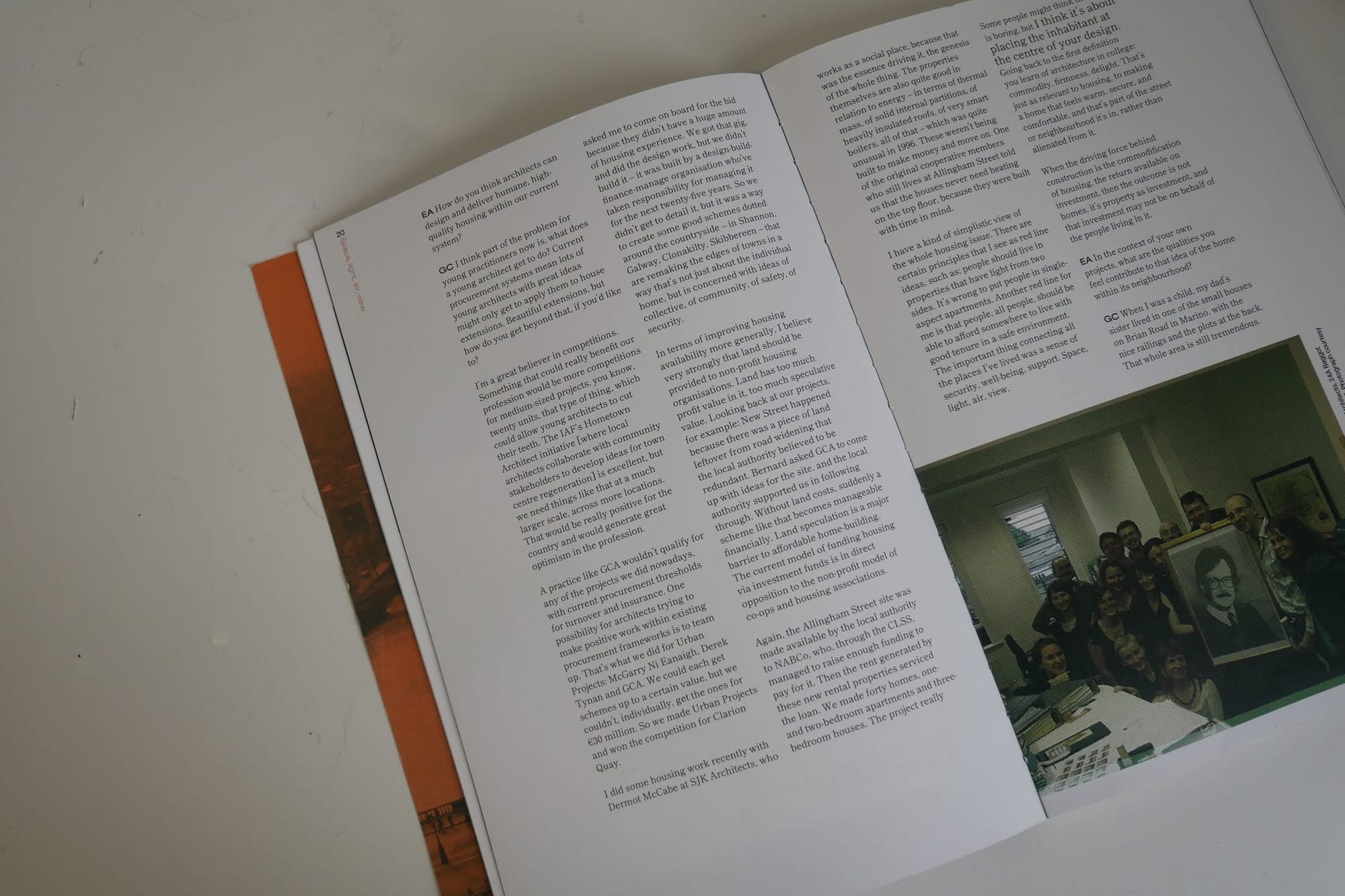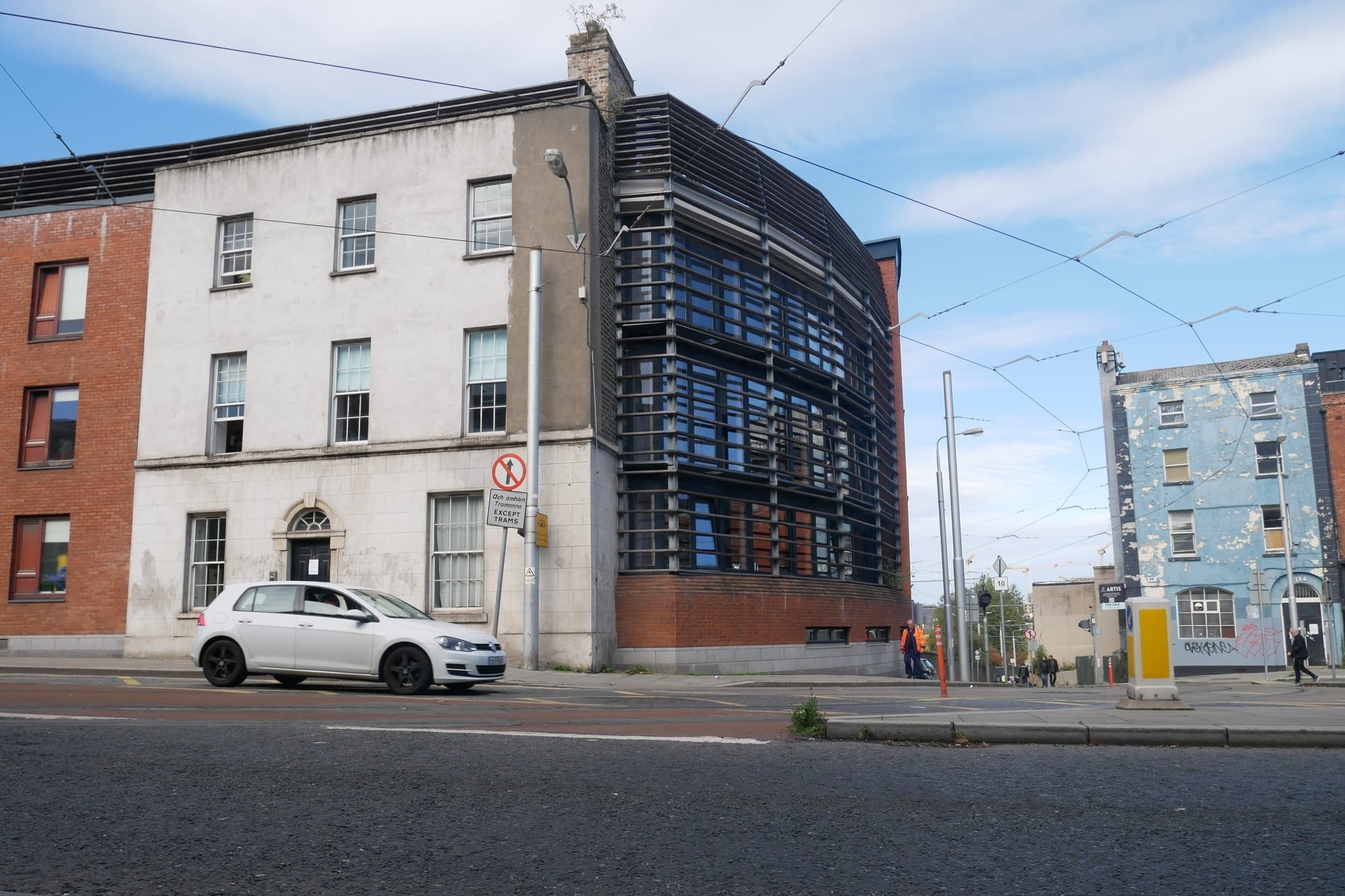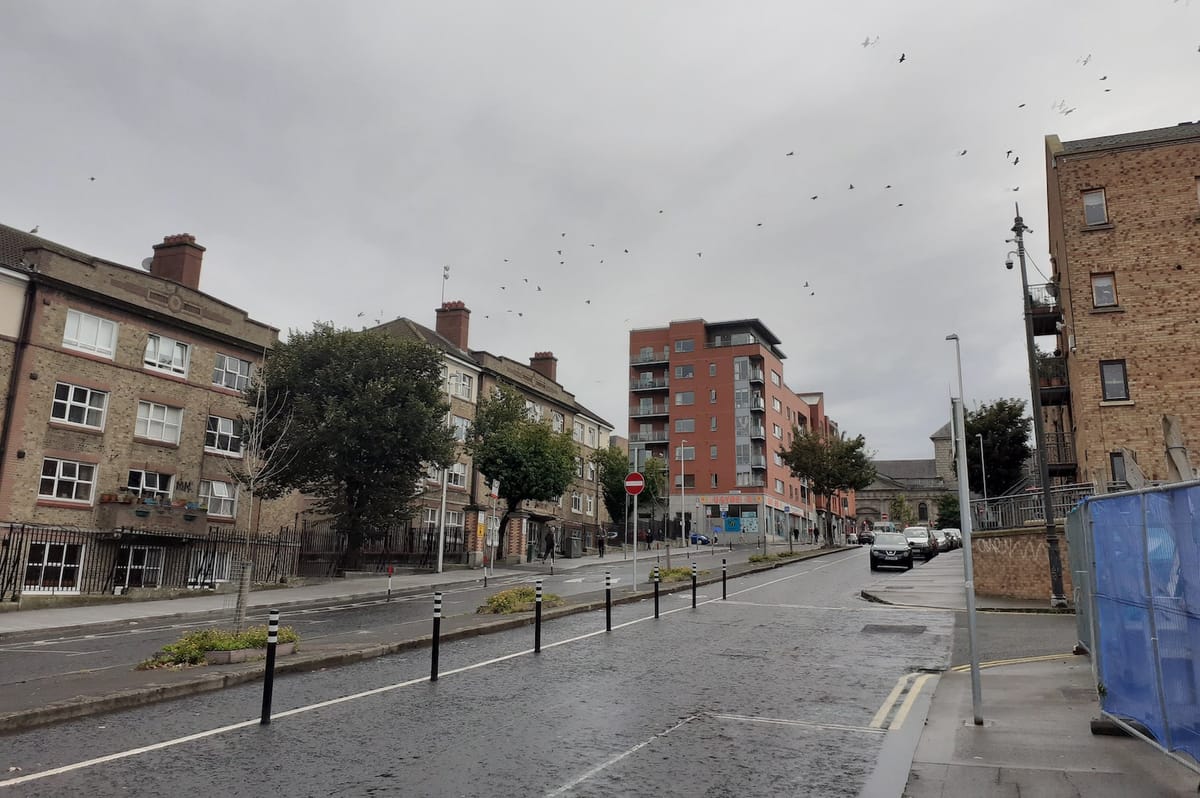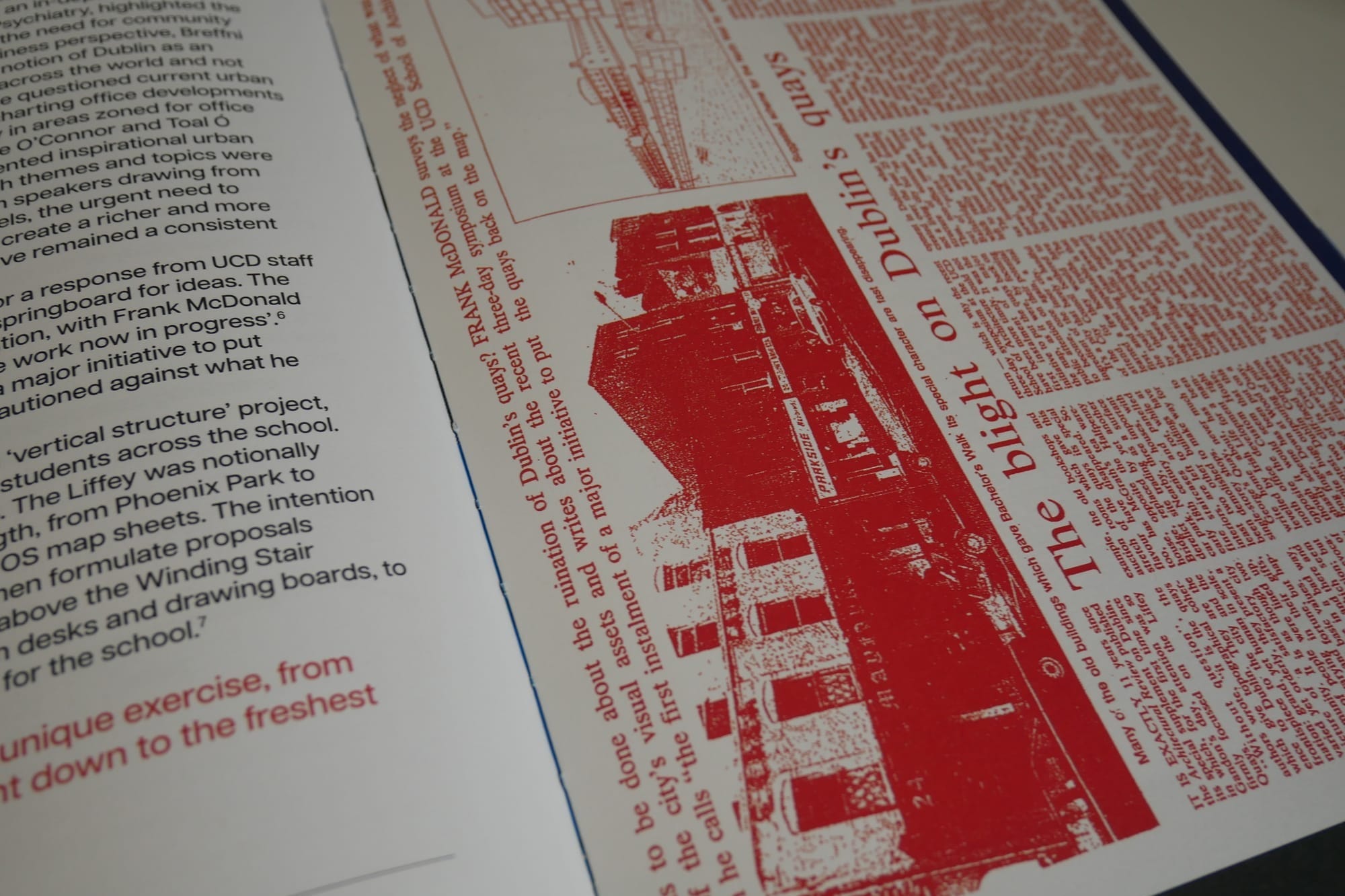Did the council follow the correct process to name Herzog Park back in 1995?
Or has Rathgar been living with Orwell Quarry Park all this time?
Each essayist in the volume, in some way, grapples with Gerry Cahill’s projects in the context of today, says Eimear Arthur, a co-editor.

The idea of a book on the life and works of Gerry Cahill grew from an interview with the architect that frustrated her, says Eimear Arthur.
Frustrated not because of what Cahill said – but because of the wider context in which he was saying it.
She was interviewing Cahill for a regular feature in the magazine Architecture Ireland called First Five Years, about what architects had done right out of college, says Arthur, and they sat together for almost three hours as he pulled down books from shelves and talked about the importance of dignified housing.
Cahill’s career as an architect and his firm’s work, from the 1980s though the 2000s, was largely devoted to social homes built in Dublin with councils, voluntary organisations, or approved housing bodies.
In the interview, he talked about the fundamentals of decent housing, said Arthur, who had earlier studied architecture at University College Dublin with Cahill, and worked at the time in housing design.
“Light, space, air, view,” she said.
And, “in a context where I mean then, and even more so now I think, there’s a lot of talk in politics and from lobby groups about how expensive and impossible it is to build dignified homes for people”, she says.
Homes with windows on both sides are said to be too expensive, balconies are too expensive, and planning processes that engage people are said to be too expensive, she says.
But there she was talking to Cahill, she says, who had been working with little money since the 1980s and on really difficult sites.
Talking about projects like Allingham Street in the Liberties where he gave thought to insulation and heating in a way that we would think is modern, she says, but driven by a desire to make them cheap for people to heat.
“And it just kind of shows that with a bit of creativity and commitment,” says Arthur, “I suppose, you can achieve things, you can achieve good housing for people if good housing is the outcome you want. Not units.”
The interview stayed with her.
So, when Arthur and her colleague Michael Hayes at Type.ie were pondering what to focus their next publication on, they settled on the collection launched earlier this month: Care and consideration: on the work of Gerry Cahill Architects.
Care and consideration combines essays, with sketches, glimpses of old newspaper articles and photographs that shed light on the ethos behind Cahill’s architecture, and several housing projects across Dublin.
At the launch, Ellen Rowley, an architectural historian and lecturer at University College Dublin, talked about Cahill as a collaborative practitioner.
Somebody who always talks about the other people who worked on projects, said Rowley, who also authored a chapter in the book.
Those collaborators include Bernard Thompson, the founder of the National Association of Building Co-operatives (NABCo) and Sr Stanislaus Kennedy, the nun, social activist, and founder of Focus Ireland.
Rowley’s piece in the book looks closely at two sheltered housing projects, at Sundial House, and at Stanhope Green which Cahill worked on with Sr Stan.
Cahill and Sr Stan are rooted in similar ethoses, said Rowley.
Sr Stan understood how bad poverty was and was influenced by the liberation theology of South American bishops, she says.
Cahill meanwhile was interested in the revolutionary self-builds of Walter Segal, the homes enabled by architects and shaped over time by the home-owner-builders themselves, she says.

On the phone recently, Cahill recalled a formative experience while he was a student that helped motivate his commitment to good housing.
“In those years, the Christmas post was a thing,” he says. And there were seasonal jobs for students as postal carriers.
He and another student got work, and were based on Griffith Avenue, with a route that took them around the old terraces of Mountjoy Square, and Henrietta Street.
“It was the remnants of Georgian tenements,” he says. Water dripped through ceilings and plaster peeled from the walls.
The conditions people were living in there stuck with him.
Cahill found solutions, says Rowley.
She points to the work of Gerry Cahill Architects in remaking suburban housing estates in South Dublin, captured in an essay in the collection by Eddie Conroy, the former county architect with South Dublin County Council.
At the time, the council area had swathes of low-density housing, dominated by traffic and unloved vast green spaces “amalgamated to reduce the cost of grass-cutting”, the essay says.
“These are really problematic placeless exurban communities, and the homes aren’t working,” says Rowley. Cahill came in and changed that, she says.
The council wanted to concentrate on placemaking with infill schemes – adding density with diverse housing types, regenerating open spaces, upgrading the fabric and energy performance of existing homes, and improving connectivity.
Cahill worked on an estate in Kilcronan in Clondalkin, another in Avondale in Tallaght – difficult sites, with social problems.
In Kilcronan, the design solution brought in a strong urban structure, and improved the amenities and landscape, and built out semi-private areas – a hallmark of his developments – with the homes,the essay notes.
It’s really hard to add new stuff onto old, says Rowley. Not just physically, but also to manage the bureaucracy, she says.
“But he wraps it and fixes it, and adds these little pieces in between. Almost jigsaw puzzle, lego stuff,” she says.
Rowley says that with their project to convert a convent at Stanhope Green, Cahill and Sr Stan were also solving a problem – and came up with something new for Ireland.
This was sheltered housing for people who had been homeless and had differing needs – some living independently, and others in need of daily checks.
The Housing Act 1988 had just been brought in, addressing urban homelessness. It gave much bigger grants for housing for homeless people – and they thought they could make that work, said Rowley.
Cahill and Sr Stan hustled through the bureaucracy to get funding. “They just went up, they kind of dressed themselves up like two naive goats, you know?”
They had to try to fit in as many people as they could, she said, asking themselves “What is the smallest amount of space that you can create, without making someone go mad?”
They made a library too, a restaurant for people from the outside world to come in, and a shared kitchen – on top of the ones within the small homes, she says.
“To have your family, who you might be estranged from – so you invite them in, and get the bigger kitchen for that,” she says.
Stanhope Green was a pioneering endeavour.
Nobody else was converting convents into sheltered and supported housing, says Rowley. “That one led to the floodgates.”
Around the corner, the Presentation Sisters at George’s Hill asked Sr Stan what she had done – and in turn, handed their convent over to Focus Ireland and Gerry Cahill too, says Rowley.
The Sisters of Charity did the same across the city in the Liberties in Basin Lane, she says, and Sophia Housing were given the Mercy Convent on Cork Street.
These are buildings that would likely have found a different fate, if renovated today, she said. “Things that today would be so overdeveloped.”
Later, Cahill also worked on Sundial House, which sits at the end of James’s Street in the Liberties, as the Luas track curls around the corner to head southwards towards Heuston Station.
Managed by Depaul Ireland, Sundial House has dwellings for people who have been long-term homeless and live with entrenched alcoholism.
It was built to break the cycle of people being on the street, drinking, hospitalised, and back on the street, says Cahill.
It was a difficult project to get over the line, says Cahill – but they did it. “I still go back there every so often, and I still find it incredibly moving.”
They had to incorporate an old listed house at the end of James’s Street, he says. “It had been used as a shooting gallery for people.”

They took the old house and wrapped a big new building around it, he says. “It creates this amazing courtyard inside.”
Because people had been street drinkers their whole lives, they didn’t want to go inside initially, he said. “They wanted to sit in the courtyard even if it was raining.”
“What I like about it too, is the big sitting room, the three-story atrium is the front sitting room,” he said. “You can look out on the city. You’re not hidden.”
Sundial House was built during the Celtic Tiger, said Rowley. “When there’s so much hardcore big developer work going on, and the more critical practices are doing these big beautiful critical houses.”
Cahill went a different way with his projects.
That’s one reason why she calls him an “outsider architect”, she says. “They don’t seem to fit into a cultural mode and they’re not corporate things either.”
Arthur says she and Hayes were really interested in the book grappling with Cahill’s work from the vantage point of today. “What are the differences between then and now?”
In the essay “How we live together: GCA in the Liberties”, Maggie Stephenson considers the importance of shared open space for apartment buildings.
Cahill managed that even in constrained spaces, Stephenson writes.
As with a housing complex on New Street, built on a site leftover from one of the road-widening schemes that ripped through inner-city streetscapes from the 1960s through the 1980s.

Cahill designed the housing with NABCo. With it, he sought to repair the damage of the carriageway schemes to the historic lines of the street.
To the council, the awkward site at New Street was leftovers, says Cahill.
Yet “no site was impossible”, he says. “But it had to be done with an attitude that it wasn’t all going to be about semi-Ds. But about apartments that answer the group that need the housing.”
They had good architects working on it, with thought to orientation, communal space, playspace for the children, a very tiny amount of carparking, he said.
“There was that kind of sense that the buildings then had spaces in them for communal management,” said Cahill.
So they had a tenants’ meeting room, he said. NABCo would meet with tenants beforehand and they would sign up to co-manage the co-op, he says, which is the best way he has seen to manage housing schemes.
Though the site was a tight space, light was still considered.
The scheme was also wrapped around a west-facing garden – and terraces and balconies are incorporated into the fabric of the building, so the light comes through the building in the morning and evening, says Cahill.
“You can go up to New Street and see it is still true,” he says.
In her essay, Stephenson contrasts the care of New Street with private-sector schemes around the neighbourhood with dead interior courtyards to meet codes but not conceived “to facilitate family, lifelong or collective living, with poor consideration of storage and private open space”.
Standards and codes as targets, and tick-boxes, are a motif in the volume.
Arthur, the co-editor of the collection, said that one of the takeaways for her is the importance for architects of a client’s aspirations.
Cahill had clients such as Sr Stan and Bernard Thompson, of NABCo, she says, “who shared his aspirations”.
Dublin councils are doing lots of good retrofit and regeneration work today, she says – such as the pilot project at Constitution Hill by Grafton Architects, and work by A2 Architects at George’s Place in Dún Laoghaire.
“The thing that the good schemes often have in common is a client who values the quality of the homes as well as the cost of delivering them. The state is well-placed to be that client,” she says.
Other bits of the landscape were different from today also, Arthur says.
Much of his work for housing associations was only possible because they were given the land, she says.
Now in the post-crash years, much land has been sold off or developed by private actors beholden to the market, she said. “It’s not a good-value way of developing that land.”
“One of the biggest costs that we have in housing is the price of the land itself,” she says.

Also, much of the time Cahill and his partners were operating on trust, she says. They weren’t being paid upfront, or at deadline but frontloading the work so they would be paid after homes were delivered, she said.
Cahill says that handling that risk was really tough. “It was bloody difficult.”
They got to the point where if they had enough projects running, effectively one was funding the other, he says. “I think we broke even at that stage of the game.”
Procurement doesn’t really allow for that now, he says. “I know that people have done feasibility studies for sites, and then the person who did it wouldn’t get the job.”
“The job has to be advertised up to planning stage – so you procure something to planning – and then a separate stage to construction,” he says. It has been difficult for young firms of architects to take jobs and run with them, he says.
Arthur says she doesn’t want to romanticise the trust arrangement. Not all architects can do that – and especially not now. “There isn’t the same ability I don’t think to defer payment.”
Cost of living was much lower for all in the 1980s and 1990s, she says.
Today, young architects are a victim of that same housing crisis that they’re trying to work within, says Arthur.
Rowley says that Cahill had to be imaginative with his materials, given the tight budgets he worked within.
But step inside the buildings to experience them and the light, and the volume, and the care and it’s clear how lovely they are, she says. “He makes a lot with very little.”
Care and consideration: on the work of Gerry Cahill Architects is available through the Type.ie website, the Library Project, Alan Hanna’s bookshop in Rathmines, and the bookshop of the Royal Institute of Architects Ireland.
[This article was updated at 1pm on 17 October 2025 to more accurately reflect comments on how Gerry Cahill did a lot with little.]